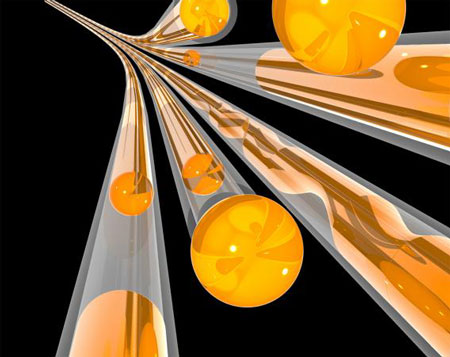| Posted: Jun 27, 2014 |
Watching nanofluids flow in 4D real-time (w/video)
|
|
(Nanowerk News) At the nanoscale, where objects are measured in billionths of meters and events transpire in trillionths of seconds, things do not always behave as our experiences with the macro-world might lead us to expect. Water, for example, seems to flow much faster within carbon nanotubes than classical physics says should be possible. Now imagine trying to capture movies of these almost imperceptibly small nanoscale movements.
|
 |
| This artistic rendering depicts fluid-filled nanotubes changing with time. Caltech researchers used four-dimensional electron microscopy to visualize and monitor the flow of molten lead within single zinc oxide nanotubes in real time and space. (Image: Caltech)
|
|
Researchers at Caltech now have done just that by applying a new imaging technique called four-dimensional (4D) electron microscopy to the nanofluid dynamics problem. In a paper appearing in the June 27 issue of Science ("Observing liquid flow in nanotubes by 4D electron microscopy"), Ahmed Zewail, the Linus Pauling Professor of Chemistry and professor of physics, and Ulrich Lorenz, a postdoctoral scholar in chemistry, describe how they visualized and monitored the flow of molten lead within a single zinc oxide nanotube in real time and space.
|
|
The 4D microscopy technique was developed in the Physical Biology Center for Ultrafast Science and Technology at Caltech, created and directed by Zewail to advance understanding of the fundamental physics of chemical and biological behavior.
|
|
In 4D microscopy, a stream of ultra-fast-moving electrons bombards a sample in a carefully timed manner. Each electron scatters off the sample, producing a still image that represents a single moment, just a femtosecond—or a millionth of a billionth of a second—in duration. Millions of the still images can then be stitched together to produce a digital movie of nanoscale motion.
|
|
|
|
When this lead-filled zinc oxide nanotube was laser-heated, some of the molten lead squeezed out of the tube through a leak. This video shows the extrusion being reabsorbed once the tube cooled.
|
|
In the new work, Lorenz and Zewail used single laser pulses to melt the lead cores of individual zinc oxide nanotubes and then, using 4D microscopy, captured how the hot pressurized liquid moved within the tubes—sometimes splitting into multiple segments, producing tiny droplets on the outside of the tube, or causing the tubes to break. Lorenz and Zewail also measured the friction experienced by the liquid in the nanotube.
|
|
"These observations are particularly significant because visualizing the behavior of fluids at the nanoscale is essential to our understanding of how materials and biological channels effectively transport liquids," says Zewail. In 1999, Zewail won the Nobel Prize for his development of femtosecond chemistry.
|

